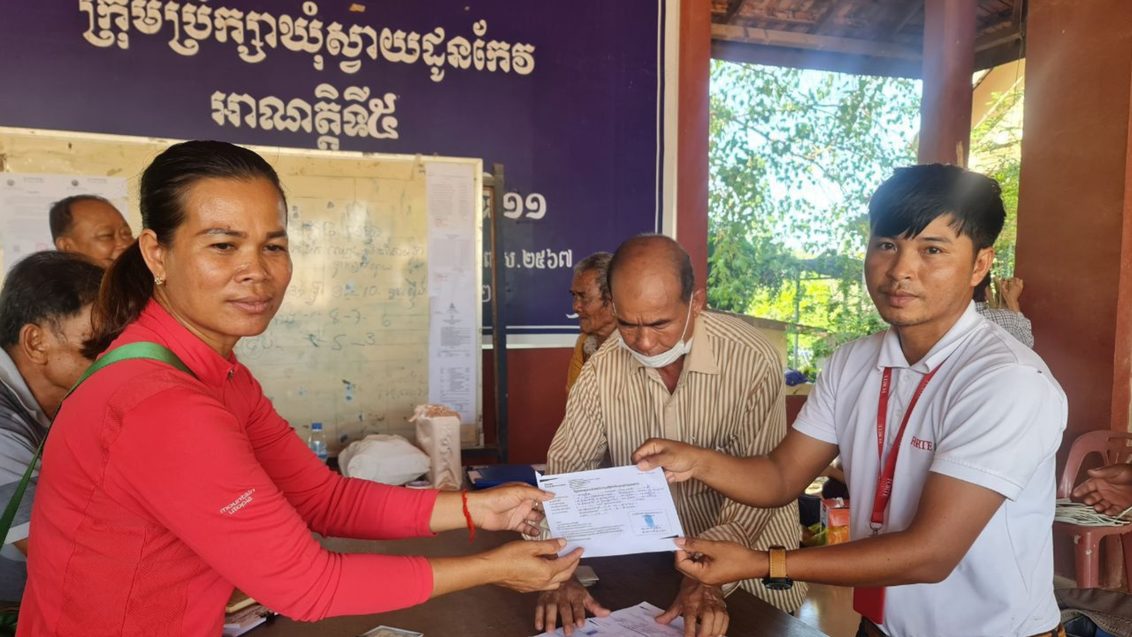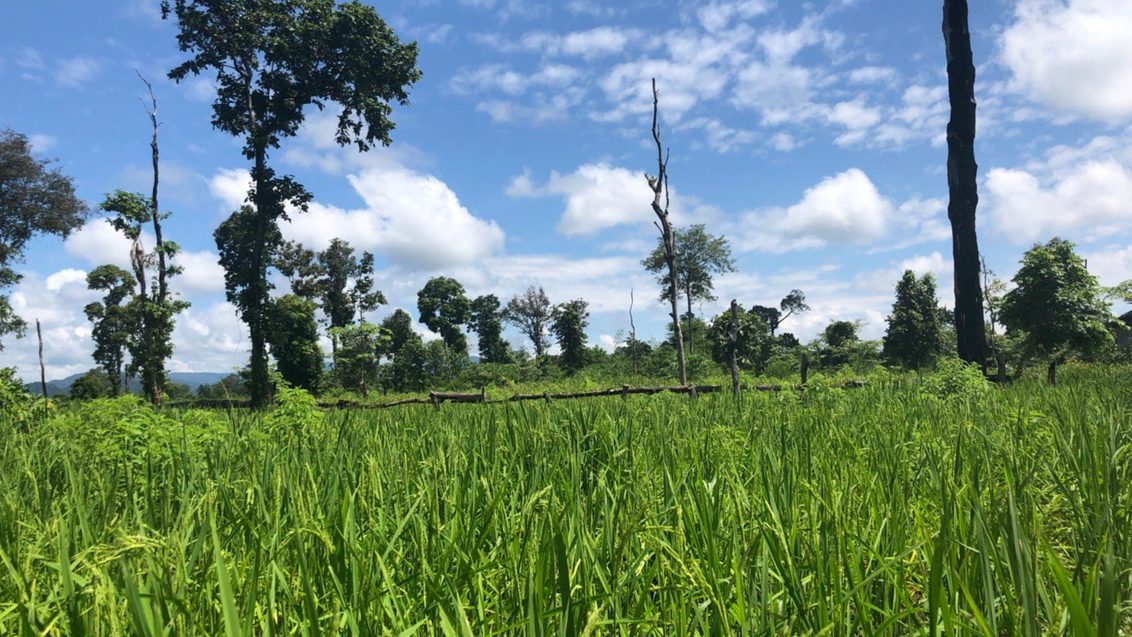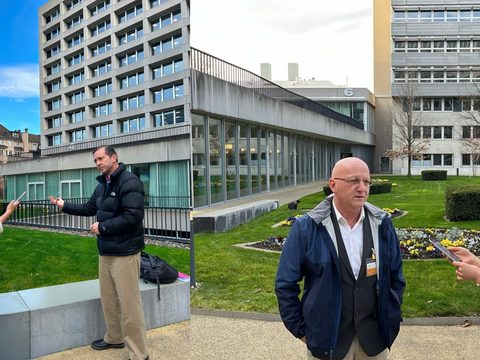Education, fish and an aptly named app

Weather insurance starts to take off in Cambodia
Run Sreay Teav is a smallholder in Pursat Province, Cambodia. And she’s a pioneer: She recently became the first farmer in her area to buy weather insurance. That’s because Sreay Teav quickly saw the value of this crucial tool in tackling climate risks. We asked our local project manager, Sophary Long, to tell us more.
Syngenta Foundation: Run Sreay Teav grows rice. What are her main weather risks?
Sophary Long: Drought and floods. In October 2020, for example, a flash flood destroyed about 80% of the rice production in her area. This year, the rains came late. So Srey Teav and her neighbors are expecting a smaller crop than in 2022.
When our Foundation started insurance work in Kenya 14 years ago, the first taker was also a woman…
Yes: Women pay more attention to the finances! Men tend to be more interested in production techniques. Here in Cambodia, we ran a major financial education program to prepare for the introduction of insurance. There were more female participants than men. The women listened to how crop insurance can protect against financial losses. They were keen to purchase insurance policies.
Financial education is important, but a policy only helps if smallholders can afford it. What’s the picture in Cambodia?
The government’s Rice-Weather Index Insurance Scheme is subsidized. For our one, smallholders take an informed decision to pay the full premium. They can choose from two models. Option 1 provides 90% protection – i.e., 10% of any yield loss is at the farmers’ expense. Option 2 protects 80%, leaving the farmer to carry 20% of yield loss. The premiums are 6% and 3%, respectively.
What does the insurance cover?
Non-preventable risks – in other words: drought, floods, storms, hail, and cyclones. The cover runs from the start of production until harvest, which is about three months. The total sum insured per hectare is $162. That enables farmers to restart their rice production if needed, and pay for seeds, fertilizer, and labor.
Why is ag insurance important in Cambodia?
The country’s economy is agriculture-based; most of the farmers are smallholders. Economic losses due to extreme weather have vastly increased in the last 50 years. As a result, smallholders are often reluctant to invest more in their crops. Insurance is a great mitigation tool because it shifts the burden of risk from farmers’ shoulders.
Ok, but why is our insurance program needed alongside subsidized state cover?
Since 2014, various development organizations, financial institutions, the government, and supply chain partners have all worked on commercial crop insurance. However, take-up remains extremely low. That is mainly because of a lack of awareness among smallholders, as well as some implementation factors. The other main point is that we are offering different cover. Ours is Area Yield Index Insurance, a yield guarantee program. The government’s Weather Index Crop Insurance only covers losses due to rainfall variation.
Our Foundation has lots of international experience with crop insurance. But in Cambodia, policies also cover freshwater fish production. What are the climate risks for aquaculture, and what protection is on offer?
This year, we’re testing weather index insurance with a small group of fish farmers. Many of their problems are like those for crops: floods, severe temperature fluctuations, and low or badly timed rainfall. High water temperatures cause oxygen depletion, which stresses the fish and can kill them. Flooding damages the ponds and other equipment, and it can let fish escape. All these problems reduce farmers’ production. Our insurance addresses heat and rainfall issues. Next year, we aim to move towards fuller product launch.
Why do you put so much emphasis on training?
Crop insurance is a new concept for Cambodian farmers. Training allows them to explore the benefits – and also to understand that any payouts depend on the weather! Importantly, we don’t just stop after financial education, but follow up with the farmers during and after the season. We listen to their opinion on local weather conditions and the usefulness of insurance. The farmers can also suggest improvements to the insurance products for the next season.
Establishing crop insurance doesn’t happen overnight. What has been the story so far in Cambodia?
We began with a feasibility assessment in 2018-2020; financial education also started in 2019. We are now in product upscale, which runs through till 2024. We have invested a great deal of time in mobilizing the farmers, partners, and other stakeholders while creating awareness and providing training. Thanks to that, we are now at a stage where World Vision, iDE, IBIS Rice and the national Rice Federation are ready to implement crop insurance across their operational areas in Cambodia.
Who are the main partners?
On the implementation side, FORTE Insurance and AMK Microfinance Institution. Financial assistance comes from the Swiss Capacity Building Facility (SCBF). The company IBIS Rice has played an important role in roll-out and adoption. (See box below*). World Vision and iDE are further important partners. With them, we’re designing innovative risk mitigation products for freshwater fish and vegetable growers.
An AMK app has also played a big role…
Yes. It’s called Tonlesap, named after a big lake that is vital for Cambodian agriculture. The Tonlesap app shares a wide range of agricultural knowledge and information, and it connects farmers with suppliers and buyers. The app is the result of cooperation between AMK and the Ministry of Agriculture, with funding from several international organizations. Ms. Sok Sireirath at AMK provides great technical support. We at the Foundation have used the app to share educational materials, for example for financial literacy. So far, we’ve trained more than 7700 smallholders face-to-face and created awareness among several thousand more via Tonlesap, Facebook, and YouTube. In the 2023 wet season, more than 1000 farmers have taken out weather insurance on rice, maize, and cassava. This is the first time all three crops have been insured in the same season.
Organic rice and climate-smart insurance |
|---|

*IBIS Rice is the first Cambodian company to introduce a crop insurance scheme to smallholders as part of its climate-smart approach. IBIS works with farmers to safeguard the environment while farming premium organic jasmine rice. The rice is certified, carefully packed, and exported to Europe. The IBIS contract farmers earn a good price. But they need to apply organic standards and climate-smart techniques – for example, using cover crops and compost. They are not allowed to cut down trees but can farm around them. IBIS pays the full insurance premium to protect farmers against weather risks and encourage them to follow its standards.
Here's more on Cambodian aquaculture. |

